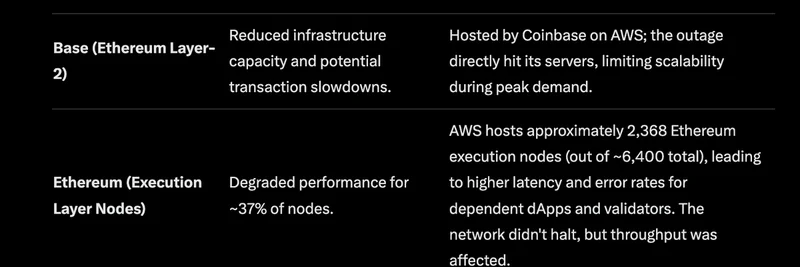In the fast-paced world of crypto, where meme tokens thrive on hype and rapid transactions, reliability is everything. A recent AWS outage has thrown a spotlight on some potential weak links in popular blockchains, sparking discussions about true decentralization. Let's dive into a viral thread on X that breaks it down, and explore what this means for meme token enthusiasts.
The Spark: Greg Osuri's Take on Chain Performance
It all started with a post from Greg Osuri, founder of Akash Network (@gregosuri), who noted: "We're paying attention to chains whose performance is degraded due to AWS outage and will contribute heavily to our decision on our new home." Akash Network, for those new to it, is a decentralized cloud computing platform powered by its native token $AKT, aiming to offer an alternative to centralized giants like AWS.
This comment highlights a key issue in blockchain: if a chain slows down because of a problem at a third-party service like Amazon Web Services (AWS), is it really as decentralized as it claims? Decentralization means spreading out control and operations so no single point of failure—like a cloud provider outage—can bring things to a halt.
MartyParty's Summary: Breaking Down the Impact
Enter MartyParty (@martypartymusic), a crypto commentator and music producer, who replied with a spot-on analysis in this thread. He called it an "excellent liveness test of run time decentralization," essentially saying this outage is a real-world check on how robust these networks are.
MartyParty shared a handy summary table showing the effects on specific chains:
From the table, we see:
Base (Ethereum Layer-2): This popular scaling solution, hosted by Coinbase on AWS, faced reduced infrastructure capacity. That could mean slower transactions during peak times—bad news for meme token launches or viral trading sprees where speed is crucial.
Ethereum (Execution Layer Nodes): About 37% of nodes saw degraded performance. AWS hosts roughly 2,368 out of 6,400 Ethereum execution nodes, leading to higher latency and errors for dApps (decentralized applications) and validators. The network kept running, but throughput took a hit.
Ethereum's execution layer handles the actual processing of transactions, so any slowdown here ripples through to Layer-2 solutions like Base, where many meme tokens live.
Community Reactions: From FUD to Calls for Better Chains
The thread didn't stop there. Replies poured in, reflecting the crypto community's mix of humor, concern, and opportunism:
One user, Michael (@Michael50949293), quipped: "Can you imagine if this was the $SOL? max peak FUD and this is not even raising eyebrows." Here, $SOL refers to Solana, a blockchain often praised (and criticized) for its speed but known for past outages. FUD means "fear, uncertainty, and doubt," the kind of panic that can tank token prices.
Jeycosmos (@cosmos_atom_) agreed it's a "critical point for trust."
Another, Yona Schriber (@Yonaschriber), went bold: "Outlaw them. Leave only the best. Solana."
These reactions underscore a broader debate: In a space where meme tokens can pump or dump in minutes, chain reliability directly affects your wallet. If a blockchain leans too heavily on centralized infrastructure like AWS, it might not hold up under stress—think Black Friday-level trading volumes during a meme coin frenzy.
Why This Matters for Meme Tokens
Meme tokens, those fun, community-driven assets often inspired by internet culture (think Dogecoin or newer ones like PEPE), rely heavily on accessible, low-cost, and fast blockchains. Base, as an Ethereum Layer-2, has become a hotspot for meme activity because it offers cheaper fees than mainnet Ethereum while inheriting its security.
But this outage shows a vulnerability: If AWS hiccups, Base feels it directly since Coinbase hosts it there. For meme token creators and traders:
Trading Implications: Slower transactions could mean missed opportunities in volatile markets. Imagine trying to snag a hot new meme coin only for your trade to lag.
Project Decisions: As Greg Osuri hints, teams might migrate to more decentralized chains. Solana, despite its own history, or alternatives like Akash for compute, could gain traction.
Decentralization Push: This event is a wake-up call. True decentralization isn't just buzz—it's about building networks that don't crumble when a big tech firm has issues.
For blockchain practitioners, it's a reminder to diversify node hosting and explore decentralized cloud options to bolster resilience.
Looking Ahead: Building Tougher Meme Ecosystems
As we at Meme Insider keep tabs on the evolving world of meme tokens, events like this AWS outage remind us that behind the memes and moonshots, solid tech foundations matter. Whether you're a dev building the next viral token or a trader riding the waves, keep an eye on chain health—it's the bedrock of crypto success.
Stay tuned for more insights, and remember: In crypto, decentralization isn't optional; it's essential. If you're curious about decentralized alternatives, check out projects like Akash Network for inspiration.


